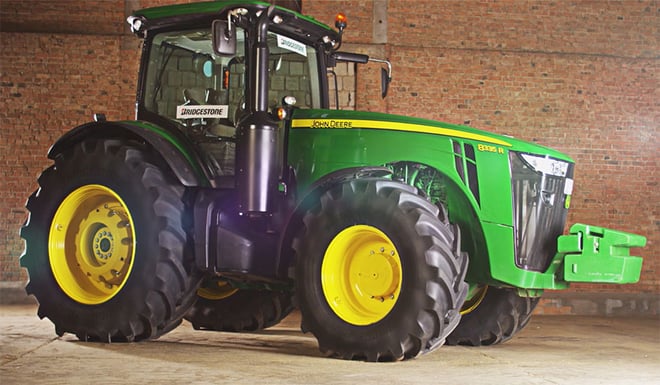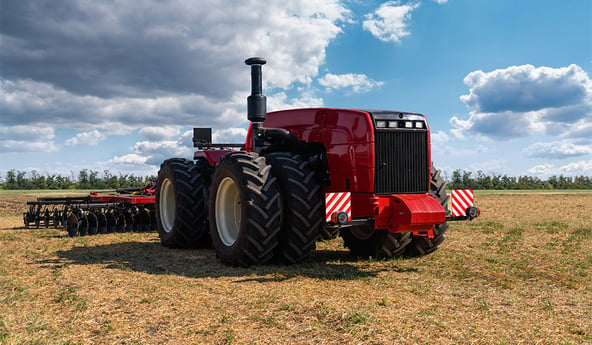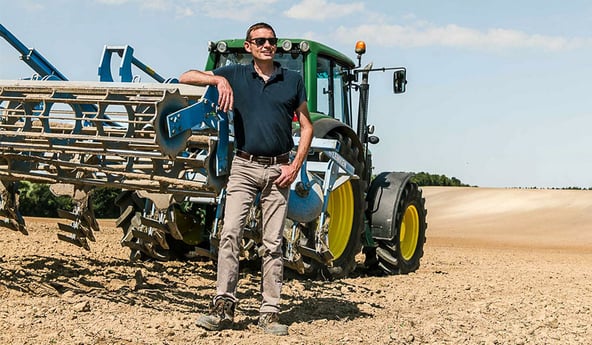Agricultural tyres generally appear quite similar irrespective of the brand, which makes it relatively difficult to spot the difference visually between top quality tyres and discount tyres. The price therefore wrongly becomes a differentiating element, as you may get the impression that you are paying for the brand rather than for the tyre, like for certain consumer goods.
Yet there is a huge difference between agricultural tyres at the level of the manufacturing process and the basic materials used to produce your tyre change everything: more resistance to wear, more resistance to perforation and cuts, more suppleness, driving comfort, tractor stability, better soil preservation and safer driving on the road…
In short, even if they look alike on the outside, top-of-the-range tyres are the fruit of the complex blending of very specific high-quality materials which offer you a maximum lifespan and optimal productivity.
Here is the list of essential materials which make the difference in your premium tyres:
1. What is the role of the raw materials which are a guarantee of quality
A top-of-the-range tyre is the result of mixing very specific doses of raw materials, developed through research and development and making it possible to optimise the tyre’s characteristics.
Here are the principal materials used in the composition of tyres and their role in improving overall quality:
Rubber
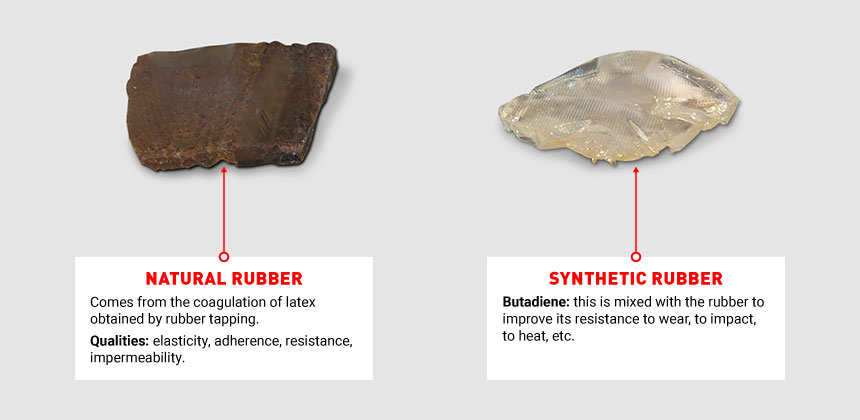
NATURAL RUBBER
Natural rubber is one of the basic components of tyre rubber, with irreplaceable elasticity, resistance, adherence and impermeability characteristics.
It comes from Hevea tree sap, in the form of a white liquid which is then coagulated to obtain natural rubber. It is perfectly suited to the vulcanisation process which transforms it from plastic to elastic.
It’s the proportional share of this basic ingredient which makes the first difference between a top quality and a low quality tyre.
Discount tyres are essentially made up of much cheaper synthetic rubber which is less durable and not recyclable.

The Bridgestone group has chosen to use sustainably managed natural resources and has its own Hevea tree plantations in Africa, in Liberia. This ecological management of resources allows the group to balance out its supplies with a long-term environmental vision, with the aim of achieving a 100% sustainable use of materials in the coming years.
SYNTHETIC RUBBER
Derived from hydrocarbons, synthetic rubber is mixed with the natural rubber to improve resistance.
- Styrene-butadiene is used in the tread to increase resistance to abrasion and reduce ozone sensitivity.
- Butadiene is used in the sidewalls to increase resistance to impacts.
Additives
They improve the basic rubber mixture and are essential to obtain a high-quality tyre. It is often on these products that savings are made in discount tyres.
PROCESSING ADDITIVES
These additives are used to obtain a perfectly uniform and supple mixture which helps to reduce the cost of moulding.

- 1. Resin
The resin acts as an anti-fixing agent which facilitates the work of the crude rubber during blending, extrusion and calendering. - 2. Oil
The oil plays a softening role, softening the crude rubber and facilitating the blending process. - 3. Bonding agent
The bonding agent ensures the cohesion of the mixture which is carried out by mechanical blending.
ADDITIVES TO IMPROVE THE TYRE
These additives improve the level of quality of the tyre, its resistance, its lifespan…

- 1. Carbon black
Derived from the combustion of hydrocarbons, this is a very important material for the tyre, making up about 30% of its composition and responsible for the black colour common to all tyres. Before the first world war all tyres were brown, the colour of natural rubber, yet carbon black is not added as a dye but for its numerous qualities:
» It increases the mechanical resistance of the rubber.
» Makes it possible to distribute temperature evenly.
» It can reduce the deflection of the tyre which keeps its initial form better, thus optimising rolling resistance. - 2. Protection agent
This is an antioxidant which protects the rubber from oxidation by the ozone or oxygen in the air to avoid the sidewalls becoming cracked over time or prolonged exposure to the sun.
ADDITIVES FOR VULCANISATION
Vulcanisation is the tyre curing stage, making it possible to create molecular chains which change the properties of the rubber from plastic to elastic.
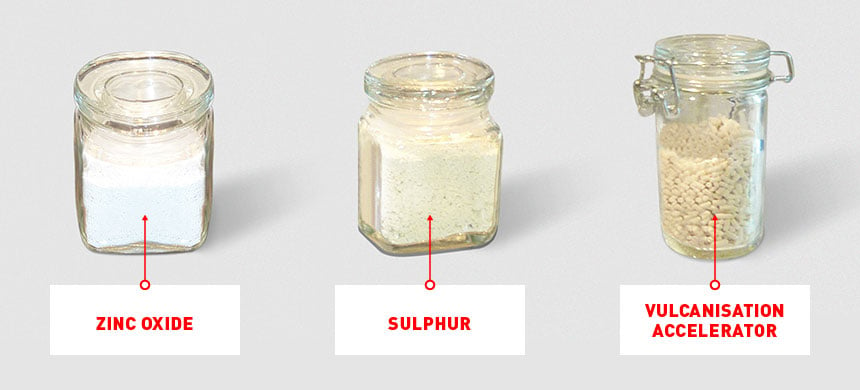
- 1. Zinc oxide
This white chemical compound, a mixture of oxygen and zinc, enables the tyre to resist rising temperatures and facilitates the vulcanisation process. - 2. Sulphur
This is one of the main vulcanising agents, which increases mechanical resistance and ensures the elasticity of the rubber, while reducing sensitivity to variations in temperature. It is a central element in molecular bridging, too much sulphur and the tyre will be too rigid, not enough and the molecule cohesion will be insufficient, making the tyre not very resistant to wear. - 3. Vulcanisation accelerator
This is a vulcanisation agent which accelerates the vulcanisation process.
2. Assembly of the materials, a key step for quality
Apart from the raw materials themselves, what gives the tyre its resistance is the highly technical assembly process, deriving from thousands of hours of tests and research and development, to obtain a top-range tyre with exceptional characteristics.
One of the essential components of tyre resistance is the inclusion of either fabric or metal fibres within the rubber.
To obtain maximum resistance, metal mesh is used which provide excellent resistance to impacts, punctures and flexion.
The disadvantage here is the excessive rigidity of this type of structure, which is particularly suitable for heavy machinery, or special tyres, such as narrow forestry tyres. These metal cables made up of twisted wires are a mixture of steel, copper and zinc.
For use with field crops or in polyculture farming, where soil preservation is crucial, tyres produced using wire cables are less suitable, therefore less common. Nylon, polyester or rayon fibre mesh is used. This fabric mesh has a major advantage in terms of elongation and reinforces the structure of the tyre, while it retains its suppleness and ability to work at very low pressure. These layers of fabric are processed in a latex bath for perfect adhesion with the surrounding rubber.
Assembly of materials
A top-quality tyre is a complex assembly which takes into account the interactions of each of the components with its environment. The rubber used for the interior of the tyre must have better hermetic characteristics in order to contain pressure, the rubber in the sidewalls must provide maximum suppleness but resist impacts, the rubber in the tread must be ultra-resistant to wear but very stable to transmit tractive force and engine torque to the ground.
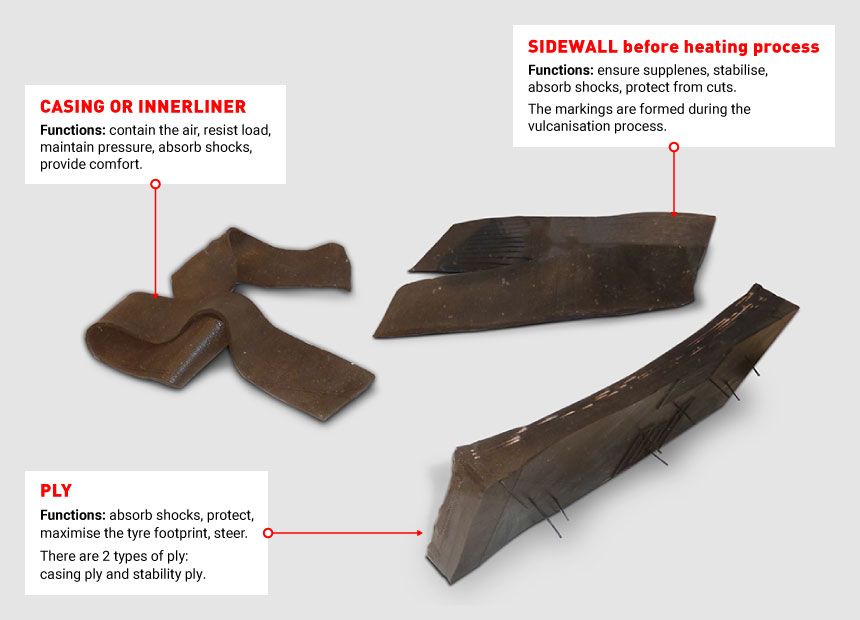
- 1. Casing or innerliner
It’s the inner tyre material which must contain air, resist loads, absorb shocks and it contains a large portion of synthetic rubber such as Isobutylene Isoprene rubber which is totally hermetic. - 2. Sidewalls
Good quality sidewalls offer maximum suppleness while preserving lateral stability. They absorb shocks and ensure protection against external cuts. - 3. Plies or mesh
These are different overlapping layers of fibres and rubber which make the tyre resistant to impacts.
The first plies ensure protection, then come the stabilising plies. They allow the full width of the tyre to be used and perfect command of steering.
The difference in the price of a tyre comes from reducing the number of plies to the minimum in discount tyres. - 4. Tread
This is the most complex assembly, the tread is part made up of rubber which ensures the link to the ground as well as many stabilising plies on top of the plies which protect the casing.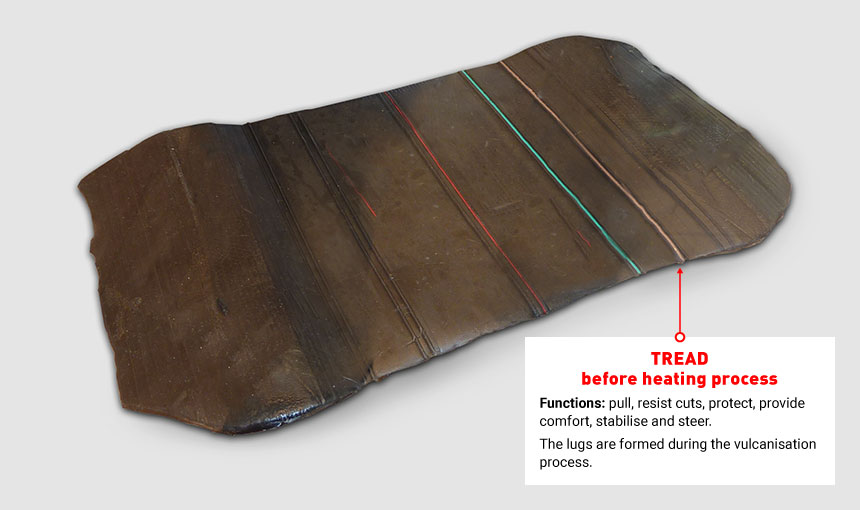
The lifespan of the tyre, its resistance to cuts and external damages depend on the quality of the tread. The final profile of the tread is obtained using the mould cavity during vulcanisation and the stability of the tractor when driving and during steering manoeuvres depends on the quality of this profile. - 5. The beads
These are extremely resistant metal wires situated on the inside of the tyre bead, essentially made of steel mixed with copper and tin for adhesion of the rubber.
They make it possible to maintain the casing ply turn-ups and reinforce the rigidity of the bead. This ensures the liaison between tyre and rim seat and enables the transmission of engine power.
3. What are the advantages of a top-of-the-range, high-tech tyre for your activity?
Like in all sectors of activity, top quality equipment cannot be judged only based on its external appearance.
Your tractor’s engine power may be very different, even if the external bodywork is similar. The same applies for the quality of tyres, but with extreme differences between tyre ranges, because unfortunately you cannot see inside the rubber unless you cut it. What is visible, on the other hand, is the performance, for which there is no comparison possible between standard tyres and top-quality tyres.

Advantage for load:
The reinforced casing is a guarantee of resistance to impacts, it makes it possible to increase the load by 40% compared to standard tyres. This category of VF tyre can easily bear variations in load during cyclic harvesting operations for example.
Advantage for pressure and soil preservation:
The very special sidewall concept will enable maximum flexion during general use, making it possible to work at very low pressure, while maintaining normal working speed.
Advantage for traction:
The tread design and the overall cohesion of the tyre make it possible to improve traction and reduce slippage.
Advantage for working time:
The very special VT-Tractor technology allows you to work continuously without losing time by having to change tyre pressure when going from road to field or the other way round.
Driving at low inflation pressure on the road will not alter your tyre.
Advantage for lifespan:
The use of specific materials in the rubber composition makes it possible to extend the lifespan of the tyres by several thousand hours compared to a normal tyre. The rubber compounds increase resistance to cuts and to asphalt abrasion.
Advantage for road use:
All the components as well as adapted profiles allow use on the road at greater speed, in total safety and with more comfort.

The Bridgestone-agriculture.eu blog is written and administered by tractor tyre experts who are available to provide you with the advice you need on the subject of your agricultural tyres. They allow you to maximise your productivity with information on all subjects linked to tyres: Technical data for agricultural tyres – Agricultural tyre performance – Air pressure advice, Solutions to avoid soil compaction – Sprayer tyre pressure – Why and how to ballast your tractor tyres – etc….
To take it one step further and increase the profitability of your farm, les Experts du pneu provide a free, highly detailed eBook which explains the essential role of the agricultural tyre in your productivity.
Most people who read this article have also read some of the following articles which are listed by order of popularity:
- Buying guide: 10 important tips for choosing the right farming tyres
- 4000 euros in savings per year by chosing a better agricultural tyre
- How to choose tyres for my farm trailer before the harvest?
- Standard farming tyre or forestry tractor tyre for deforestation?
- Which is better value? A cheap agricultural tyre or a VF tractor tyre
- Here’s how your agricultural tyres can save you money
- How to make the right choice for your agricultural or tractor tyres?
- Increase the yield of your sprayer with narrow VF tyres
- Do you know which are the best agricultural tyres for your sprayer?
- A good agricultural tyre is the best guarantee of sprayer stability
- What is the best tyre for my combine harvester, IF, VF or CFO?
- A hi-tech agricultural tyre to save time during your harvest
- The top 5 reasons for choosing VF agricultural tyres
- The VF agricultural tyre: VF technology increases your productivity
- Cheap agricultural tyres, discount agricultural tyres, is it worth it?
This information is intended only to make you aware of the technical and functional aspects of agricultural tires and their use. It does not allow you to make a judgment or a definitive conclusion on a given problem. Only your agricultural tire expert is able to make a technical assessment and take a final decision, case by case.
Leave a
commentary
Your email address will not be published.
Required fields are indicated with *


